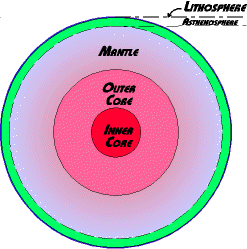STRUCTURE OF THE EARTH
And Its Origin and Fate
To understand plate tectonic theory, we need to know something about the structure of the earth. To understand this structure we need to know something about igneous rocks. If you are unfamiliar with igneous rocks, there is a brief primer that in two minutes will tell you everything you need to know to get started.And Its Origin and Fate
 The earth is approximately 12,740 kilometers in diameter, and is stratified into layers as shown in the illustration to the right. The properties of each are:
The earth is approximately 12,740 kilometers in diameter, and is stratified into layers as shown in the illustration to the right. The properties of each are:Lithosphere - the outer rigid shell of the earth's structure, extending from the surface to about 1000 km deep (outer blue line on drawing). It consists of the crust and the upper mantle. Note how very thin the lithosphere is, comparatively thinner than an egg shell. It is divided into the crust (the outermost layer) and the very upper part of the mantle (explored under lithosphere structure).
Asthenosphere - the layer or shell below the lithosphere, about 2000 km thick. It is composed mostly of ultramafic rocks (or see igneous primer) such as peridotite and dunite that are weak and plastic, and flow slowly under stress.
Mantle - layer or shell of the earth below the lithosphere and above the core; it is about 2800 km thick, although it is subdivided into many sub-layers, including the asthenosphere and lower mantle as well as others. It is composed mostly of ultramafic rocks (or see igneous primer) such as peridotite and dunite and their metamorphic equivalents (e.g. ecologite).
Core - the central portion of the earth about 7000 km in diameter. It is composed of an iron-nickle alloy. The outer core is molten, while the inner core, even though just as hot, is a solid because of the increased pressure.
The next page will focus on the structure of the lithosphere, the outermost, rigid layer of the earth, where plate tectonics occurs.
However, if you are interested in exploring the earth's origin and history, and the origin of the concentric layers, and the heat that drives the earth, you can take a side trip (heat history of the earth) there first.
Go On To: